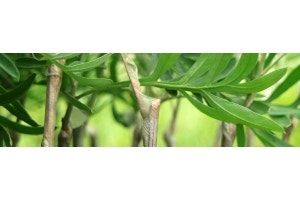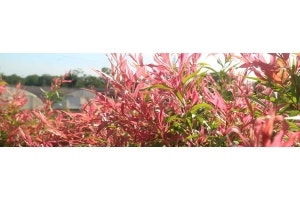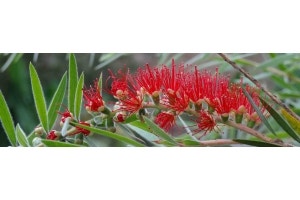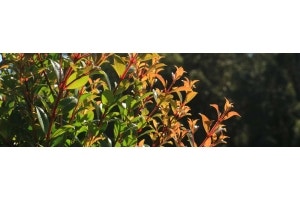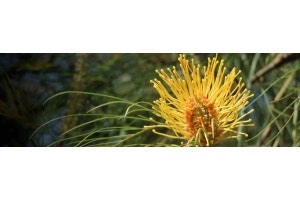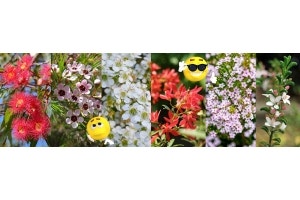
Cordylines are very popular plants for all kinds of gardens, to add bright vibrant colour and an instant tropical feeling.
As young plants, they start off as wide tufts or fountains of leaves, and then steadily develop a trunk to lift those leaves clear of the border and show them off. This makes them ideal for planting as an accent in the centre of a mixed bed or lawn.
Cordylines are also happy in pots and tubs, where their cascading tufts of leaves can be seen to great effect. So if you only have a balcony or deck you can still enjoy these dramatic plants.
There are two main kinds of cordyline for Australian gardens : fruticosa, and australis.
Both can be found all over the Oceanic region, the broad leaf fruticosa more often in the humid jungly regions of the Far East and Polynesian islands, and the narrow leaved australis in the harsher climates of coastlines and southern states.
What's the difference between fruticosa and australis? Which cordyline is best for you?
Cordyline fruticosa - broadleaf cordyline
Broadleaf cordylines have long wide leaves, with a glossy sheen, and vibrant colour - either all over the leaf, or in bold loose stripes.
Often the colour is different on the new leaves, as you can see in the image; creating an interesting contrast.
The wide leaf and glossy surface is a clue that this plant is used to dappled light and regular water, like it finds in its native homes.
The leaves grow broader to soak up as much sunlight as possible in the shady parts of the tropical forests.
It's lush and luxuriant in growth, so protect those good looks by planting it out of direct wind and scorching sun, which could damage the leaves.




Fruticosa is the cordyline to choose if :
- you live in a tropical or sub-tropical area
- you get plenty of rain or have enough water
- your garden doesn't get any frost
- you've got a shady sheltered area to plant it in.
Broadleaf cordylines come in a range of very bright colours all year round - pink, orange, purple, even black - making them ideal for vibrant tropical-style outdoor spaces. There are also more subtly-coloured varieties, which will blend into almost any style of garden.
Cordyline australis - narrowleaf cordyline
Narrowleaf cordylines have long slender leaves, often with a matt appearance, and either all-over deep colour or subtle colouring along the centre rib the base of each leaf, or along the leaf margins.
The narrow leaf and more matt surface is a clue that this plant can tolerate brighter light, and lower rainfall, as it finds in its native coastal and southern homes. The narrow leaf helps reduce evaporation, keeping any water inside the plant.
It's resilient and hardy, so it makes a great plant for sunny exposed balconies, and less-sheltered locations like coastal gardens. It's ideal for enjoying indoors by beginner gardeners, busy gardeners, and those without a green thumb, as they are really easy to grow.




Australis is the cordyline to choose if :
- you live in a cooler drier climate
- your garden gets occasional frost
- your garden is exposed or windy
- you've got a sunny area to plant it in.
Narrowleaf cordylines come in deep brick red and plum shades to almost-black; all green; and shades of green with pink and coral accents.
All can find a home in traditional colourful flowerbeds or modern minimal urban gardens.
Cordyline Dracaena Phormium - what's the difference?
Cordyline plants are often mistaken for Dracaena or Phormium plants - and sometimes it's only the experts who can tell the difference between certain varieties.
You might have noticed yourself that all three of these garden plants seem pretty similar - all three grow in a tufty fountain shape; all three have long strappy, often colourful, leaves; all three grow well in Aussie gardens.
So what's the difference between them?


Cordyline - ti plant
Cordylines are in a family of plants called the Lomandroideae. Does that look familiar? They are related to the native Australian Lomandra, the mat rush!
They are also close cousins of the New Zealand rock lily, Arthropodium Matapouri Bay, which has small white flowers and grows well in shade.
Mature broadleaf cordylines will often flower with tassels of small buds, followed by bright round berries.
You can find cordyline plants all over the southern Pacific, from tropical south-east Asia across the Polynesian islands, down to the east coast of Australia and across New Zealand. In Polynesian culture they are often called Ti plants.
Dracaena - dragon tree
Dracaenas are in a family of plants called the Nolinoideae. Nolina is the old name for what is now called Beaucarnea, the ponytail palm. They are also close cousins of snake plants, mondo grass, liriope, and surprisingly, lily of the valley!
You can find Dracaena plants all over the world; mainly in Africa and Madagascar, and also in southern Asia, northern Australia, and central America. Some grow into huge spreading trees, called dragon trees.
As their wide geographic range suggests, they are resilient and adaptable and can tolerate many climates, often challenging ones.
Phormium - New Zealand flax
Phormiums are in a family of plants called the Hemerocallidoideae. This is the same family as herbaceous day lilies with bright golden flowers, and Australia's native Dianella, the blue flax lily.
You can find Phormiums growing naturally in the wild in New Zealand and Norfolk Island. The very strong leaves with long fibres were used to make traditional Maori cloths and baskets.
Mature phormium plants will often flower on tall sturdy branching stems, several metres tall in some cases.
Get inspiration on including cordylines in your garden with our Plant The Look posts - Tropical Island style gardens, Balinese style gardens, and Florida style gardens will all look beautiful with cordylines.















